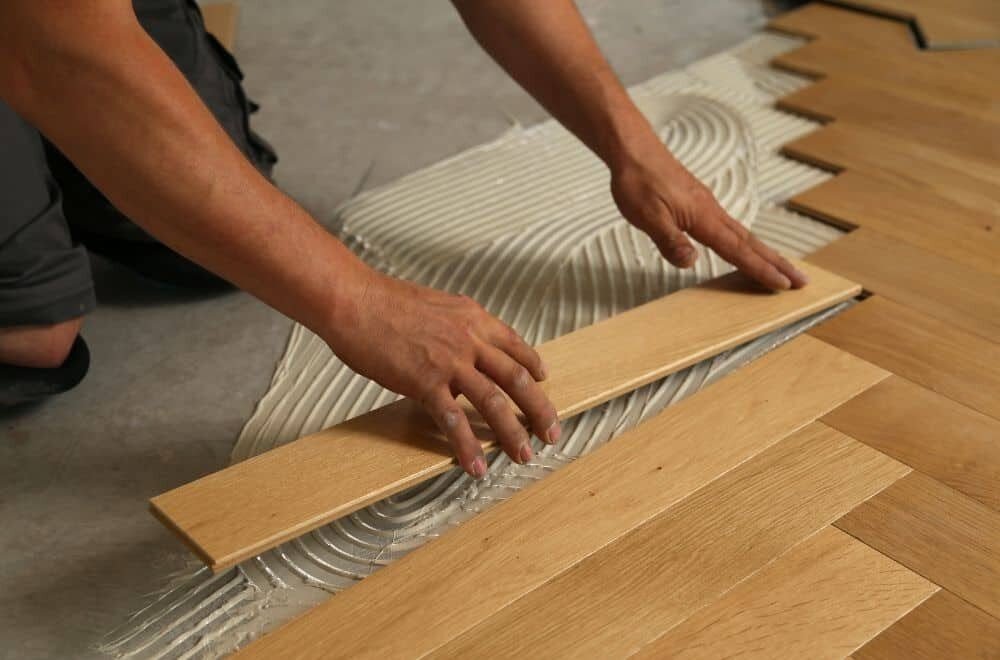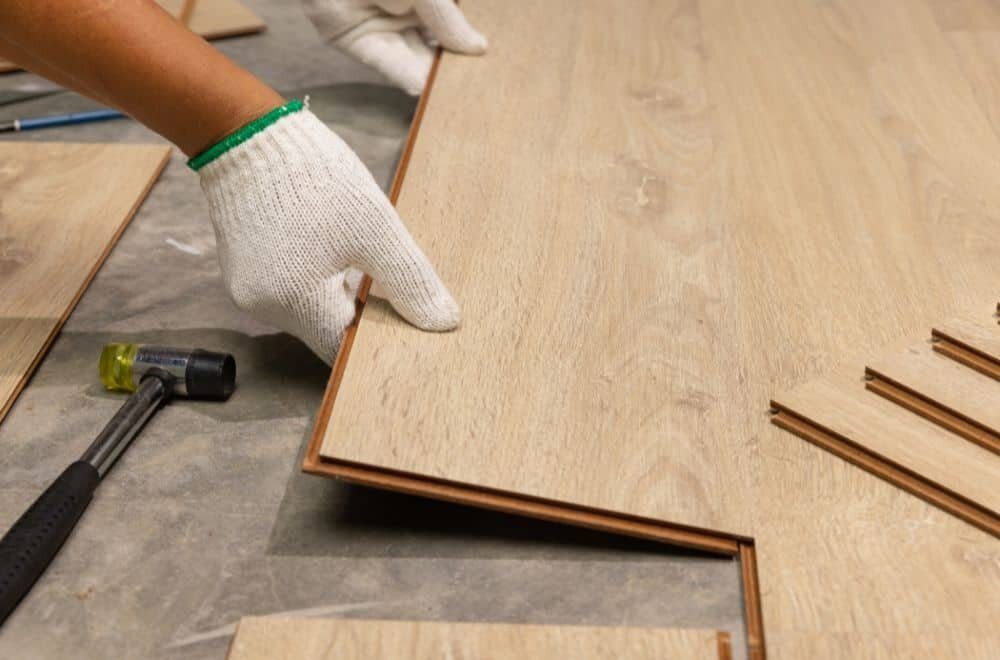Are you planning to renovate your home and have different types of wood floors in different rooms? If so, you may be wondering how to transition between two different wood floors. Transitioning between two different floors can be challenging, but it can be done in various ways. In this article, we will discuss some of the most popular ways to transition between two different wood floors.
One of the most commonly used methods to transition between two different wood floors is using T-molding. T-molding fits well if the two floors are the same height. It is a wooden or vinyl trim with a rounded top and a stem piece that fits between the gaps in your floor. Another way to transition is by using transition molding, which comes in various colors and finishes. It can be cut to size and attached using screws and pre-drilled holes or a construction adhesive.
Understanding Wood Floor Transitions

When it comes to wood floor transitions, it’s important to ensure that they are not only aesthetically pleasing, but also functional. A smooth transition between two different wood floors can prevent accidents and make your home look more cohesive. In this section, we will explore the different types of wood floors and the importance of smooth transitions.
Types of Wood Floors
Before we dive into the types of wood floor transitions, it’s important to understand the different types of wood floors. There are two main types of wood floors: solid wood and engineered wood.
Solid wood floors are made of a single piece of wood and are typically thicker than engineered wood floors. They are more expensive but can be sanded and refinished multiple times.
Engineered wood floors, on the other hand, are made of layers of wood that are glued together. They are more affordable and can be more stable in areas with high humidity or moisture.
Importance of Smooth Transitions
A smooth transition between two different wood floors is important for several reasons. First, it can prevent accidents. Uneven transitions can create tripping hazards, especially for young children and elderly people.
Second, smooth transitions can make your home look more cohesive. A seamless transition between two different wood floors can create a more polished look and feel.
To achieve a smooth transition, there are several transition options available, including T-molding, reducer strips, and threshold strips. It’s important to choose the right transition option based on the height difference between the two floors and the overall design of your home.
In summary, understanding the types of wood floors and the importance of smooth transitions is crucial when it comes to creating a cohesive and safe home. By choosing the right transition option, you can ensure that your home not only looks great but also functions well.
Preparation Steps

Before you start transitioning between two different wood floors, there are a few preparation steps that you need to take. These steps will help you ensure that the transition is smooth and seamless.
Evaluating Existing Floors
The first step in preparing for a transition between two different wood floors is to evaluate the existing floors. You need to determine the type of wood, the condition of the floors, and the level of the floors. Make sure that the floors are level and free from any damage or defects before you start the transition.
Choosing Transition Materials
Once you have evaluated the existing floors, the next step is to choose the transition materials. There are several transition materials that you can use, including seam binders, T-molding, and transition strips. Choose a material that matches the color and style of your existing floors.
Here are some tips to help you choose the right transition material:
- Consider the thickness of the wood floors. Choose a transition material that is the same thickness as your existing floors.
- Choose a material that is easy to install. Some transition materials require special tools or adhesives to install, while others can be installed with basic tools.
- Consider the durability of the material. Choose a material that is durable and can withstand heavy foot traffic.
By following these preparation steps, you can ensure that your transition between two different wood floors is seamless and visually appealing.
Installation Techniques

When it comes to transitioning between two different wood floors, there are several installation techniques you can use to achieve a seamless and visually appealing transition. Here are three popular techniques to consider:
Using T-Molding
T-molding is a great option if the two different floors are the same height. This type of molding is typically made of wood or vinyl and has a rounded top with a stem piece that fits between the gaps in your floor. To use T-molding, leave about 1 3⁄4 inches (4.4 cm) of space between the two floors so some of the subfloor is exposed. Then, simply snap the T-molding into place.
Creating a Saddle Transition
A saddle transition is a type of molding that is used when the two different floors are at different heights. This technique involves creating a gradual slope between the two floors using a piece of wood or other material. To create a saddle transition, you’ll need to measure the height difference between the two floors and cut a piece of wood to fit. Then, attach the wood to the lower floor using construction adhesive and screws. Finally, sand and finish the saddle transition to match the surrounding floors.
Installing a Flush Transition
A flush transition is a type of molding that is used when the two different floors are at the same height. This technique involves installing a piece of molding that sits flush with the surrounding floors. To install a flush transition, you’ll need to measure the width of the gap between the two floors and cut a piece of molding to fit. Then, use construction adhesive to attach the molding to the floor. Finally, sand and finish the molding to match the surrounding floors.
No matter which installation technique you choose, it’s important to take your time and ensure that the transition is level and secure. With a little patience and attention to detail, you can create a seamless and beautiful transition between two different wood floors.
Maintenance and Care

When it comes to maintaining and caring for your transition between two different wood floors, there are a few things to keep in mind. By following these tips, you can ensure that your floors remain in good condition for years to come.
Cleaning Tips
Regular cleaning is essential to keep your transition looking its best. Here are some tips to keep in mind:
- Sweep or vacuum your floors regularly to remove dirt and debris that can scratch the surface.
- Use a damp mop to clean your floors, but avoid using too much water, as this can cause damage over time.
- Avoid using harsh chemicals or abrasive cleaners, as these can damage the finish of your floors.
Repair and Replacement
If your transition becomes damaged or worn over time, it may need to be repaired or replaced. Here are some things to keep in mind:
- If your transition is damaged, it may be possible to repair it rather than replacing it entirely. Consult a professional to determine the best course of action.
- If your transition needs to be replaced, make sure to choose a high-quality replacement that matches the style and color of your existing floors.
- Consider hiring a professional to install your new transition, as this can ensure that it is installed correctly and will last for years to come.
By following these tips, you can ensure that your transition between two different wood floors remains in good condition and looks great for years to come.
Frequently Asked Questions
What are some options for transitioning between two different types of wood flooring?
When transitioning between two different types of wood flooring, there are several options available. One option is to use a transition strip, such as a T-molding, to create a smooth transition between the two floors. Another option is to use a contrasting wood or stain to create a deliberate design choice. You can also use a patterned or textured rug to help blend the two floors together.
How can I blend new hardwood floors with old hardwood floors?
Blending new hardwood floors with old hardwood floors can be tricky, but there are a few things you can do to help make the transition smoother. One option is to use a transition strip, such as a T-molding, to create a seamless transition between the two floors. Another option is to use a contrasting wood or stain to create a deliberate design choice. You can also use a patterned or textured rug to help blend the two floors together.
What are some ideas for transitioning between different colored wood floors?
When transitioning between different colored wood floors, there are several ideas you can use to create a cohesive design. One option is to use a transition strip, such as a T-molding, to create a seamless transition between the two floors. Another option is to use a contrasting wood or stain to create a deliberate design choice. You can also use a patterned or textured rug to help blend the two floors together.
What is a T-molding transition and how can I use it for my wood floors?
A T-molding transition is a type of transition strip that is used to create a smooth transition between two different types of flooring. The T-molding is installed by placing the stem piece between the two floors and attaching the rounded top to the stem piece. This creates a clean and seamless transition between the two floors. T-molding transitions can be used for wood floors, as well as other types of hard flooring.
How do I transition between two different types of hard flooring?
Transitioning between two different types of hard flooring can be done using a variety of transition strips. One option is to use a T-molding transition, which is a type of transition strip that is used to create a smooth transition between two different types of flooring. Another option is to use a reducer strip, which is used to transition between two different types of flooring that are at different heights.
What are some wood floor transition strip options for different floor heights?
When transitioning between two different types of flooring that are at different heights, there are several options available. One option is to use a reducer strip, which is used to transition between two different types of flooring that are at different heights. Another option is to use a stair nose transition, which is used to transition between a stairway and a different type of flooring. A T-molding transition can also be used for different floor heights, as long as there is enough space between the two floors to accommodate the transition strip.